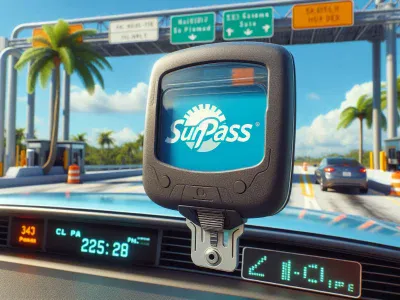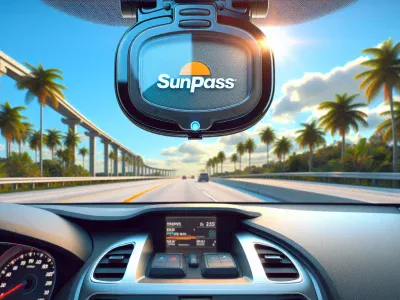Does E-ZPass Work with SunPass? Compatibility, Tips, and Travel Insights
Picture this: you’re cruising down a sun-soaked highway in Florida, the breeze rushing through your open window. You approach a toll booth and suddenly wonder—will your trusty E-ZPass work here, or are you about to hit an unexpected roadblock? For frequent travelers and road trippers alike, navigating different toll systems can feel like decoding a puzzle.
Understanding whether E-ZPass and SunPass play nice together isn’t just about convenience; it’s about saving time, money, and avoiding unnecessary stress. These electronic toll systems might seem interchangeable at first glance, but their compatibility—or lack thereof—can make or break your seamless journey. So before you hit the gas on that next adventure, let’s jump into how these systems connect (or don’t) and what it means for you.
What Is E-ZPass?
E-ZPass is an electronic toll collection system widely used in the United States. It operates across 19 states, including New York, New Jersey, Pennsylvania, and Virginia. With an E-ZPass transponder mounted on your vehicle’s windshield, you can pay tolls automatically without stopping at toll booths.
This system links to a prepaid account you manage online or through mobile apps. When you pass through a toll plaza equipped with E-ZPass technology, the transponder communicates wirelessly with the system to deduct the correct amount from your balance.
E-ZPass simplifies travel on highways and bridges by reducing wait times at manual toll lanes. For example, if you’re commuting daily over tolled routes like the George Washington Bridge in New York City or traveling along I-95’s high-occupancy express lanes in Virginia, this convenience can save significant time.
Users benefit from discounted rates on some roads and bridges compared to cash payments. According to ezpassgroup.com (2023), drivers using E-ZPass often receive up to 25% off standard toll rates depending on specific agency policies.
This interoperable network connects multiple regional agencies under one account but doesn’t cover every state nationwide. Understanding where it works ensures seamless trips without unexpected issues at non-participating locations.
What Is SunPass?
SunPass is Florida’s electronic toll collection system designed for seamless travel. It enables drivers to pay tolls without stopping at booths, using a transponder linked to a prepaid account. Managed by the Florida Department of Transportation (FDOT), SunPass covers highways, express lanes, and most toll roads across the state.
Two types of transponders are available—SunPass Mini and SunPass Pro. The Mini adheres to your windshield, while the Pro is portable and compatible with multiple vehicles. Both connect to an online account where you can monitor balances, add funds, and view transactions.
Beyond Florida, the SunPass Pro works in 19 states accepting E-ZPass. Examples include Georgia’s Peach Pass lanes and North Carolina’s Quick Pass systems. But, compatibility varies depending on your transponder type.
Using SunPass saves time through automated payments and offers discounted rates compared to cash or Pay-By-Plate options. For instance, travelers on Florida’s Turnpike often pay up to 25% less per trip when they use SunPass over traditional payment methods.
If you’re navigating regions outside Florida regularly or planning cross-state trips, understanding where your transponder functions improves efficiency. Double-checking coverage maps ensures smooth transitions between regional toll networks like E-ZPass or Peach Pass zones.
Compatibility Between E-ZPass And SunPass
E-ZPass and SunPass are two distinct toll systems serving different regions, but certain overlaps exist. Understanding these connections helps you navigate toll roads across multiple states seamlessly.
States Where E-ZPass Works With SunPass
E-ZPass and SunPass work together in specific scenarios where interoperability agreements exist. The SunPass Pro transponder is compatible with all 19 E-ZPass states, including New York, Pennsylvania, Virginia, and Illinois. But, the standard SunPass Mini doesn’t operate outside Florida’s toll network.
For example, if you’re traveling from Florida to Georgia or South Carolina using a SunPass Pro transponder, it integrates smoothly with E-ZPass facilities. This compatibility allows convenient transitions without switching accounts or devices. Coverage maps provided by the Florida Department of Transportation (FDOT) can clarify areas supported by both systems.
Restrictions And Limitations
Even though some compatibility between E-ZPass and Sunpass Pro transponders, restrictions remain based on device type and regional agreements. A regular E-Zpass transponder cannot process tolls within Florida’s exclusive Sunpass-supported zones unless it’s explicitly marked for multi-state use.
Also, not all toll plazas accept both systems even in overlapping coverage areas due to technical limitations or administrative policies. For instance: older infrastructure on certain highways may only recognize their native payment methods—resulting in manual payments or violations if unsupported transponders are used.
How To Use E-ZPass With SunPass
E-ZPass and SunPass compatibility depends on using the proper transponder. Travelers can maximize convenience by understanding integration steps and troubleshooting methods.
Steps For Seamless Integration
- Choose Compatible Transponders
Use a SunPass Pro transponder for travel across E-ZPass regions, covering 19 states like New York, Pennsylvania, and Virginia. Standard SunPass Mini only works within Florida’s toll network.
- Activate Accounts Correctly
Ensure your prepaid account is active before traveling by linking it to your transponder via the FDOT website or mobile app for SunPass or the corresponding platform for E-ZPass users.
- Verify Coverage Maps
Check FDOT’s official coverage maps to confirm supported areas where both systems function, especially near regional borders with mixed acceptance policies.
- Ensure Proper Mounting
Install the transponder securely on your windshield as per manufacturer guidelines to avoid misreads at toll plazas, reducing delays or fines.
- Monitor Account Balances
Maintain sufficient funds in your account since negative balances may lead to violations or manual payments at unsupported toll booths.
Tips For Troubleshooting
- Address Payment Errors Quickly
If a toll charge doesn’t process correctly, contact customer service for either system (FDOT for SunPass; respective authority for E-ZPass) with transaction details like date, time, and location.
- Update Vehicle Information Regularly
Register any new license plates promptly to prevent mischarges when switching vehicles linked to your account.
- Check Device Functionality Before Travel
Test the transponder periodically by passing through local compatible tolls; malfunctions often result from depleted batteries in portable devices like SunPass Pro units.
- Resolve Interoperability Issues Locally
In cases of disputes between systems—for example, if an E-ZPass charge fails on Florida roads—visit nearby service centers operated under FDOT jurisdiction where support staff assists directly.
Benefits Of Using E-ZPass And SunPass Together
Combining E-ZPass and SunPass simplifies travel across regions with different toll systems. With a single compatible transponder like the SunPass Pro, you can access toll roads in Florida and 19 E-ZPass states without needing separate devices. This reduces clutter on your windshield and streamlines payment processes.
Using both systems together saves money through regional discounts. For instance, Florida’s Turnpike offers up to 25% off for SunPass users, while E-ZPass provides similar savings on highways like the New Jersey Turnpike or Pennsylvania Turnpike. By leveraging these local benefits, you can reduce overall travel costs significantly.
Time efficiency improves when you avoid cash lanes or manual payments at tolls that accept both systems. Interoperable transponders allow seamless transitions between states like Georgia (Peach Pass areas) and New York (E-ZPass zones). You spend less time stopping or adjusting to payment methods during long trips.
Account management becomes easier since prepaid balances from one system cover multiple areas. If your trip spans from Florida to Virginia, for example, funds linked to a single account handle all transactions automatically without requiring additional setups.
Compatibility ensures fewer violations caused by unsupported devices at certain plazas. A properly registered SunPass Pro avoids issues where standalone E-ZPass or standard SunPass Mini might not work due to regional restrictions.
Travel flexibility increases as interoperable systems expand coverage areas over time. Future agreements may include more states within the compatibility network, offering greater convenience for frequent travelers covering diverse routes nationwide.
Alternatives If E-ZPass Does Not Work With SunPass
- Use a SunPass Pro Transponder
Switching to a SunPass Pro transponder enables compatibility with both Florida toll roads and the 19 states in the E-ZPass network. This device is portable and works across regional systems, eliminating the need for multiple transponders. Ensure activation and account linking before travel to avoid payment issues.
- Consider Toll-by-Plate Options
Many toll roads in Florida support Toll-by-Plate, which captures your license plate image at toll points and bills you later. Though convenient, this option often incurs additional administrative fees compared to using electronic transponders like SunPass or E-ZPass.
- Purchase State-Specific Transponders
If frequenting areas outside of Florida or E-ZPass regions, acquiring state-specific devices like Georgia’s Peach Pass or Texas’ TxTag ensures seamless access to local toll networks without relying on interoperability agreements.
- Plan Routes Using Non-Toll Roads
Use navigation tools to identify alternative routes that bypass tolled highways altogether if system compatibility is uncertain or unavailable for your trip.
- Explore Rental Car Agreements
Some rental car companies offer integrated toll payment options through partnerships with major providers like SunPass and E-ZPass. Verify terms and potential surcharges before opting for this service during vehicle rentals.
- Pay Manually Where Allowed
In cases where neither system operates effectively, check if cash payments are accepted at specific plazas or use online portals post-travel for manual settlements when supported by local authorities.
| Alternative | Key Benefit | Limitation |
|---|---|---|
| SunPass Pro Transponder | Wide coverage including E-ZPass states | Requires upfront purchase |
| Toll-by-Plate | No device needed | Higher fees apply |
| State-Specific Transponders | Localized functionality | Multiple devices may clutter windshield |
| Non-Toll Routes | Cost savings on tolls | Potentially longer travel times |
| Rental Car Agreements | Convenience during short-term trips | Additional rental charges |
Exploring these alternatives helps ensure smooth travels even when facing compatibility challenges between E-Zpass & Sunpass systems.
Conclusion
Understanding the compatibility between E-ZPass and SunPass can make your road trips more efficient and stress-free. With tools like the SunPass Pro offering broader coverage, you can simplify toll payments across multiple states while saving time and money. By planning ahead, verifying transponder capabilities, and staying informed about regional toll systems, you’ll ensure smoother travels no matter where the road takes you.
- Which Is Best: DisplayPort or HDMI - November 20, 2025
- Eggshell Versus Satin: Understanding the Differences in Paint Finishes - November 20, 2025
- Amendment J in Colorado: An Overview - November 20, 2025







